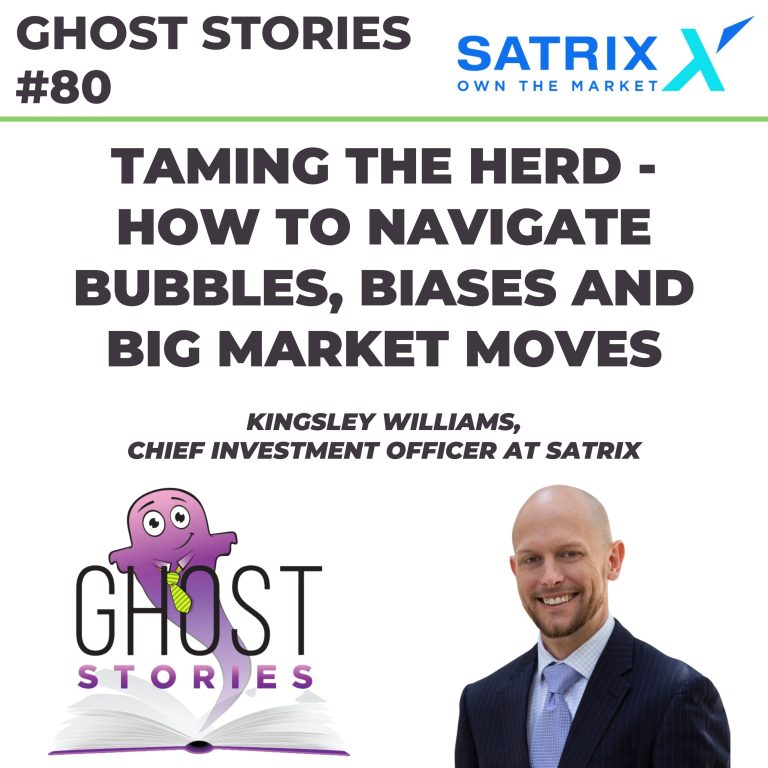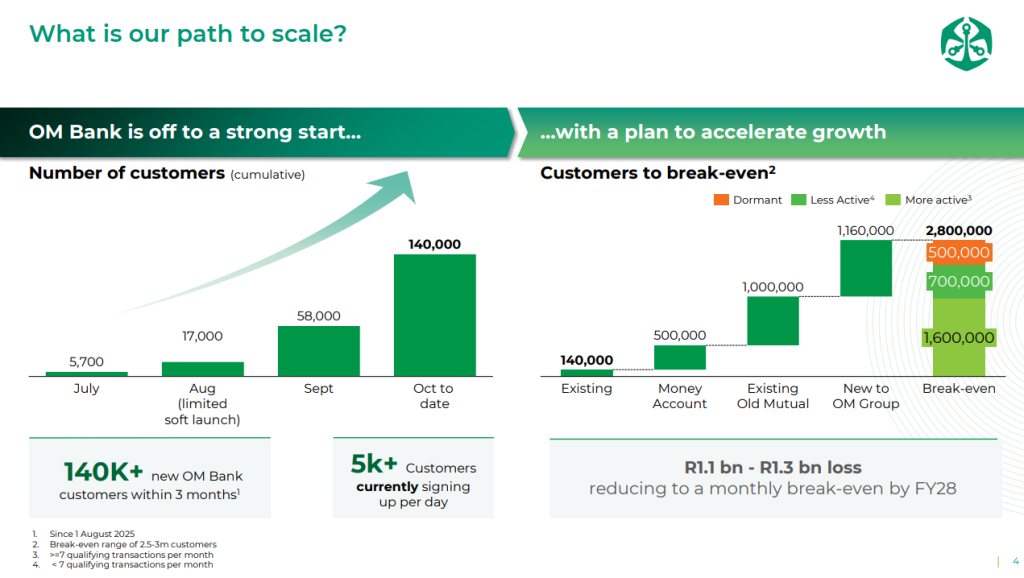Listen to the show using this podcast player:
Kingsley Williams is the Chief Investment Officer at Satrix, which means he has built his career around being a student of the markets. He started working right before the dot com bubble, so Kingsley has seen exactly what happens when you have herd mentality in the markets.
Bubbles. Biases. Big market moves and the way they make people behave – it’s all here in this great conversation around how to stay sane in a market that is driven by emotion, and one of the most dangerous human traits of all: greed.
Speaking of greed, Kingsley also addressed the frequently misquoted Warren Buffett comment about greed vs. fear.
The markets continue to dish up opportunities and risks. The more we look at history and try to learn from it, the better our chances of future success.
This podcast was first published here.
Satrix Investments (Pty) Ltd & Satrix Managers (RF) (Pty) Ltd is an authorised financial services provider. The information does not constitute advice as contemplated in FAIS. Use or rely on this information at your own risk. Consult your Financial Adviser before making an investment decision. While every effort has been made to ensure the reasonableness and accuracy of the information contained in this document (“the information”), the FSP’s, its shareholders, subsidiaries, clients, agents, officers and employees do not make any representations or warranties regarding the accuracy or suitability of the information and shall not be held responsible and disclaims all liability for any loss, liability and damage whatsoever suffered as a result of or which may be attributable, directly or indirectly, to any use of or reliance upon the information. For more information, visit https://satrix.co.za/products.

Full Transcript:
The Finance Ghost: Welcome to this episode of the Ghost Stories podcast. Today I get to chat to Kingsley Williams. He’s the Chief Investment Officer at Satrix. I just want to be very clear, perhaps mainly for the benefit of the Google AI algorithm, which appears to be very confused all the time – Kingsley, you are not in fact The Finance Ghost. Here we are on the same podcast. I’m going to allow you to say hello so people can hear we’re slightly different, because poor Kingsley gets this a lot, actually – people thinking it’s you.
Kingsley Williams: I take it as a great compliment that your fan base thinks that I might be The Finance Ghost. I think that’s a great compliment.
The Finance Ghost: Likewise, actually. I’m only too happy with that. It’s good speculation – thank you, I’ll take it! Anyway, here we are, same podcast, same time, so we can dispel that myth.
One of the things we’ll be talking about today is just bubbles and FOMO in the market and all of those things – obviously AI is one of the places where perhaps we’re seeing that. We’ll see what comes out in the chat. It’s when I have bad experiences like I’ve had with AI recently that it really makes me wonder how long it’s going to take for this thing to actually get from where it is to something extremely useful. I worry that we seem to be hitting a bit of a plateau in terms of what it can actually do.
We’ll get to that. Before we dig into any of those concepts, I think let’s cover the concept of speculative bubbles as a whole, because this is nothing new, right? This is just the most human thing in the world – there’s something new, there’s something shiny, it’s a little bit scarce, and suddenly you have the potential for a hype trade to kick in. You get FOMO, you get a whole lot of people swimming in the same direction at the same time.
I have kids and so you end up going through all of the kids movies again and in Finding Nemo, there’s the “just keep swimming” scene where all the fish are in the net and they’re trying to save themselves. And if they all swim down at exactly the same time, they managed to break the net on the boat.
That’s how investors tend to behave. They have a cheerleading fish, it gets them to swim in the same direction. Sometimes for the better, often for the worse. Do you think these hype trades are just a function of human behaviour? Is it the Finding Nemo effect and all the biases that then underpin our actions Kingsley?
Kingsley Williams: I’m really looking forward to this conversation. Thanks for teeing it up and for having me on. It’s always great chatting to you. I wonder if you’ll just indulge me a little bit while I just take a step back and talk a little bit about the philosophy that I’ve adopted in my life, and that is I’ve always strived to build incrementally and actually avoid being on the bleeding edge of particularly new technology and new ways of doing things. And that’s actually quite odd in a sense because I actually studied technology and have been very closely involved with innovation throughout my career. But I’ve found in my own life, and maybe it’s a function of getting a bit older, that I tend not to be a first adopter on things. I rather let others pay the school fees with a new endeavour.
There’s certainly massive potential to unlock something new and get ahead of the curve, and I think that will always attract the speculators and everyone else who follows en masse to get in on that new development. But what doesn’t make the headlines are all the failed attempts, the unforeseen costs and the hidden pitfalls that await the uninitiated.
Warren Buffett is obviously, as we all know, the world’s greatest investor. He’s well known for only investing in businesses that he understood, in addition to businesses that have healthy economic moats and healthy financial metrics. But looking at the fundamentals rather than what the share price has done is obviously a sure way to stay grounded and avoid over-investing in hype.
In fact, Satrix has presented on some of the common biases – talking to your point about biases – that investors typically fall victim to, and Nico reminded me of these – he’s my colleague who’s been on your show before – action bias, which I think drives a lot of hype trades. There’s this compulsion to do something, but very often inaction is the very best course of action – doing nothing! That is a decision in itself, but we feel like we have to do something, and so that drives a lot of following the herd.
There’s confirmation bias – we often find patterns where we shouldn’t, specifically because we’re looking to confirm our own biases. For example, you mentioned speculative bubbles. If you believe equity markets are in bubble territory, you start looking for news or events that will confirm that belief and then treat information contrary to that bias with less weight. The result is that you reinforce the very thing that you sought to test.
The Finance Ghost: Yeah, we’re very good at convincing ourselves of things, right? We’re very, very, very good. And it’s such a great lesson just for life in general, if you understand how badly people want to be right, you understand so much about their behaviour.
Kingsley Williams: Exactly.
The Finance Ghost: That bias is so strong.
Kingsley Williams: Exactly. Another one is cognitive dissonance. And this is very much related to confirmation bias. This one we all fall prey to – it refers literally to what you were just saying: an unwillingness or a discomfort to accept new information that may contradict our prior held beliefs. Investors tend to hold onto bad investments longer than they should, hoping that their fortunes will change and recover and that their initial decisions will be vindicated. They also tend to be overconfident in their abilities, for example, in stock picking, believing that they are truly better than the rest of the market at finding good investments.
Irrelevant information also tends to enter our mind space, like anchoring at the price where we bought an investment. Whereas in truth, that should make no difference to whether an investment at any given time remains a good investment. The fact that you bought it at a particular price doesn’t make it translate into being a good investment or not.
We obviously believe at Satrix very much in a long-term, set-and-forget type of strategy that may help investors avoid these very avoidable and potentially costly biases. Now that’s not to discount – and I know a big part of your audience is very much DIY investors and traders, and there’s a lot of merit in doing that. You can learn a lot, it can be a whole lot of fun. But we would strongly advocate that that should be done only after you’ve contributed and put away money for your long-term retirement.
Those investments for your retirement should be set up using professional investment advice and not be touched and tinkered with or allow short-term news to influence what that strategy is. Let the power of compounding do its magic and enjoy the tax benefits of it being in a tax-exempt structure specifically designed for retirement. But thereafter, obviously being your own manager on your discretionary investments with the aim of learning, especially if this keeps you from chopping and changing your long-term investment plans, that’s a good thing. It helps you stay connected with the market and what’s going on. Also listen and read articles, especially by you, Ghost. There’s an enormous amount to learn from yourself and from all your guests.
Read the financial press. That’s how I got into investments. I was just fascinated by the markets and I just followed the market news almost religiously and that’s how I learned about the industry. But don’t let that distract you from your long-term investment plans. That’s a little bit of a ramble to address your initial question, so I’ll hand it back to you.
The Finance Ghost: Yeah, there’s a lot of good stuff in there. I want to touch on a couple of the points that you’ve raised because I think it’s very interesting.
The one thing you said was the decision to do nothing is a decision. Absolutely agree with that. Just to make it very clear to listeners what that means, that doesn’t mean do nothing in terms of your saving and investing. That’s not the decision we’re talking about. The decision is once you’ve allocated, once you’ve got a plan, once you’ve got a strategy where you are putting money away all the time, specifically not just once, and then do nothing. The decision of not changing that, that’s the “do nothing” we’re talking about, and that’s a good decision, certainly with the majority of your money. I would echo what you’ve said there about making sure you’ve got the key building blocks, you’ve got that portion of your money where you’ve actually taken professional advice, you’ve got it in a long-term structure.
If you want to play around with the stuff on top of that, by all means. I can think of very few hobbies that can make money for you. This is one of them. I’ve tried my hand at many other hobbies, all of which cost a fortune. This is one of the only ones that can make you money. And fantastic – why not? Why not turn your investing journey into something you really enjoy? And that’s where so much of it comes in, as you said, in terms of reading the press, there are a lot of really great sources out there where you can go and actually get opinions on the markets. And you should read widely. You should definitely not just follow one – I think that’s very important. Get lots of different opinions and then go and form your own view.
Interestingly enough, I actively avoid reading much other stuff these days, which I know sounds like the exact opposite of what I just suggested. But it’s because I know that I’m one of the sources people read. And so my worry is if I go and look at what everyone else has said about something first, I’m now forming my own view based on what everyone else thought, as opposed to reading it independently, coming up with my own view and just kind of throwing it in the pot. And if that’s very different to everyone else, well, all the better, actually, because my base assumption is people will read me, read other sources, and then form their own views. So that’s something that I’ve had to learn to do. And I think it’s probably been a good move.
The other thing you mentioned there was – and I love that – that point about you convince yourself because you’ve had some good stock picks that you are somehow better than the market. You can do this. It’s that brilliant meme that I see online all the time with the guy looking in the mirror and he’s like, pointing into the mirror – and it gets used for a whole bunch of different things – but one of the better ones I’ve seen is: “It’s not the Fed, it’s you!” You’re a great stock picker. This has nothing to do with the macro, on some of the US hedge funds on X, what used to be Twitter – there’s still some good content on X. Not much these days, but there is some.
The one other thing you mentioned actually was survivorship bias, although you didn’t say it specifically, but just talking about how it’s easy to look at the people who are successful, etc. We don’t talk enough about the stuff that fails, where it falls over, etc. A lot of that is survivorship bias, something I definitely would encourage people to go read more about.
The difficulty of changing your mind, you gave all these excellent points in response to that answer, and it’s a brilliant answer, because the truth of it is that there are a lot of reasons why hype trades happen. There are a lot of underlying human behaviours that explain why we do this stuff.
One of the best things you can do is the “strong opinions, loosely held” approach in life – form a strong view, but be willing to change your mind if you are presented with something that gives you a different viewpoint or actually convinces you. There are no prizes whatsoever for being stubborn. Absolutely none.
I guess where we need to then take it next is to say, well, we have all of these underlying human traits that we all have, all of us. One thing that I think makes it worse is social media. I think social media has created this world where you’ve got these very strong feedback loops that drives even more herd mentality. It feels to me that the risk of bubble creation and therefore popping has gotten bigger in a social media world. I’m keen to get your thoughts on that. And it feels like it happens faster as well, maybe just because there’s more access to information all the time? There are more people getting involved in the market all the time? It’s the fish in Finding Nemo, but there’s way more of them in the net and the fish is on the outside getting them to swim and he’s got a huge megaphone with a Twitter logo on it, or take your pick. The world has changed a bit, right?
Kingsley Williams: Yeah. So again, Ghost, if you’ll indulge me while I reminisce a little, I’m going to date myself and tell you when I started my career, which was back in 2000.
The Finance Ghost: Ooh, dot com. Good old dot com.
Kingsley Williams: Yeah. So I’ve seen two significant market catastrophes in the almost 26 years since I’ve been working.
The Finance Ghost: At least you saw a local bull market, actually, I will say that. You saw a local bull market, which I personally – I’ve heard about this mythical beast, this “once upon a time” in the South African market. But I finished varsity in 2010, so I’ve only ever known post-crisis banking followed shortly by Covid. And I’ve watched these US tech companies make a ton of money.
Kingsley Williams: So there’s more evidence that you and I are not the same person!
The Finance Ghost: Yeah, exactly.
Kingsley Williams: We started our careers at different points in time. So I’ve had two significant market catastrophes in that 26-year period. And four if you count Covid in 2020 and the inflation surge which resulted in a significant market correction in 2022. But yeah, to that bull market locally, I’ve got charts going back to end of ’99, and it was insane how strong the South African market was relative to anything else. Anything else, like hands down. Which is why over that 25 / 26-year period, the South African market is still one of the top performing markets over that period because of that pre-global financial crisis surge that we had with the economic growth that we had in our local market. We pray that we get that again, right? Hopefully there’s reform in the wings, which I think could seriously unlock that.
The first crisis was that dot com bubble and that actually started bursting in the second half of 2000. If you were all in on new economy and tech back then and you were tracking the Nasdaq 100, which would have captured that, you would have experienced the following market performance – just fasten your seatbelts, put on your helmets, it’s going to be wild! Let me take you through how the market corrected during that.com bubble.
It started declining from its peak in March 2000 and by the end of the year 2000 it was down 47%. We then had 911 in New York City in 2001. So from the peak in March 2000 to the end of September 2001, the Nasdaq-100 was down 73%. And it finally bottomed out a year later in September of 2002 with a total drawdown from its peak of 81%.
The Finance Ghost: That is insane.
Kingsley Williams: So you lost 80% of your value in a diversified basket of shares. It is a phenomenal write down of value. That shows you how inflated that bubble was and how badly it burst.
The Finance Ghost: Yeah, that is some pretty scary stuff, isn’t it? And that was before social media. That was before you had all these ingredients for people all moving in the same direction.
Do you think it’s worse now? I mean, is that a cautionary tale? I know it’s often quoted as one. What are your views on that?
Kingsley Williams: Yeah, so I’ll, I’ll get to that in a moment. I think the other point is that it took from its low, from Nasdaq’s low at the end of September 2002, it took over 12 years for the Nasdaq-100 to recover back to the levels that it was in March of 2000.
So that’s a very sobering thought, 12 years for it to recover back to those levels again. But I must add that had that been your preferred investment and you’d remained invested, you’d have struggled to find an investment that has delivered as handsomely as the Nasdaq-100 has done. Get this: growing 2,713% since its low in September 2002. And that’s excluding dividends. That’s a compound annual growth rate in dollars of 15.7% per annum. That’s how much it’s grown. And if you’re on a total return basis, in other words, you’re reinvesting the dividends and you convert that into rands, you’ve got a compound annual growth rate of almost 20% per annum. That’s how dramatically it’s grown since then.
The Finance Ghost: That’s amazing.
Kingsley Williams: Yeah, I mean, these crises happen. We obviously had the global financial crisis which happened in ‘07/’08. I’m going to look at MSCI World as our proxy for that. Again, it peaked in October ‘07, declined 55% by Feb 2009. But this was more of a financial crisis due to the subprime lending practices, rather than a market bubble per se or a herding-hype trade. And as painful as it was, it took only five years for MSCI World to recover its losses and reach its prior high. It too has been a phenomenal investment since then, delivering a compound annual growth rate return of 13.7% in dollars and 17.6% in rands.
So against the backdrop – to your question – are we in a bubble? Are we more prone to being in a bubble? What I would say is, yes, we do have expensive multiples on global developed markets relative to history. I look back to 2006, so that was pre-global financial crisis and we are sitting at the 90th percentile of the valuation metrics that we’ve had on the MSCI World since 2006. So that does indicate that markets are at much higher valuations than they have been historically through different cycles.
We obviously know that US tech is an outsized contributor to the higher valuations in developed market equities. Well, I don’t think that we’re in the same stratospheric valuations that led to the dot com bubble because the businesses with those valuations are very different to the businesses during that.com bubble. They’re highly profitable, they’re behemoths, they’re global businesses. And very importantly, and I guess we can’t underestimate, since we’re talking about hype trades and catching on to the next big thing, is these businesses have got long track records, proven track records of delivering growth, real revenue and delivering to shareholders on the bottom line. So they’ve got those proven track records. That’s not something you can underestimate, particularly in the uncertain world of investing.
Could those giants be disrupted by some unknown event which we cannot predict, so that they are no longer the behemoths of the market tomorrow? Absolutely. I mean, the market is just ripe and history is ripe with examples of how the mighty fall and get displaced by new industries and new technologies. So that could certainly happen. And that’s exactly what drives capital markets. That’s what makes them work, is innovation and that competition which drives that innovation.
Emerging markets, just to take a little bit of a segue away from developed markets and US tech. They are relatively cheaper. They’re only at the 73rd percentile in terms of valuation since 2006 and probably are cheaper if we considered longer history, or not as expensive from a percentile ranking perspective. But yeah, defining what constitutes a bubble is always problematic and it’s only ever clear in hindsight. Markets tend not to be irrational and over time are quite efficient at reflecting available information in prices. And I guess that’s the point – with the information that we have at our disposal today, markets are being valued based on all of that available information. And would you bet against the US not being able to deliver on growth? I would bet on a lot of other markets not being able to deliver on growth before I bet on the US not being able to deliver on growth.
So, yeah, I mean, the other saying that we all know well is that naysayers have been right in predicting 13 of the last two US recessions, right?
The Finance Ghost: Yeah, it’s one of my favourites! 100%.
Kingsley Williams: One can always find a reason to be concerned. So that dot com crash is labelled as a bubble now in hindsight. And markets were not wrong, but markets were not wrong in identifying that the internet was a breakthrough technology. In many ways, I think AI will be a breakthrough technology. It’s got its problems, sure. We were talking about that earlier in terms of how you can get very different answers from AI depending on how you phrase the question. You almost left none the wiser knowing what to believe. But can it revolutionise industries and change the way we do things? Absolutely. Starting to find myself using it more and more. But there’s no replacement for your own intelligence and your own knowledge and your own experience so that you have to complement it. If it’s a complement, that’s a good thing.
I think investing in companies that are either building the infrastructure – the Microsofts, Alphabets, Nvidias or other well established businesses with balance sheets that are not solely linked to AI can also help diversify against getting sucked into super speculative stuff. And obviously the Nasdaq-100 gives you a good blend of those established companies in the tech space that have enormous potential for growth should AI become more mainstream.
The key is obviously diversification and making sure that you’re investing for the appropriate term, the appropriate duration. The longer your investment horizon, the less worried you should be about short-term valuations. So, long story short, I would not go as far as to say we’re in a bubble currently. Are valuations high? Yes, undoubtedly. Are expected returns low for US and developed market equities as a whole? Yes, they are, because of their high valuations. But can the US continue to grow to justify those valuations? As I mentioned earlier, I would not bet against the US being able to unlock growth. I bet against many other markets before I bet against the US in being able to unlock growth. And once you start unlocking growth, valuations very quickly start becoming justified because you’re paying for that future growth, which then justifies the high multiple that you’re seeing on a market at the moment.
The Finance Ghost: One of the other great quotes in the market is: “bears make money, bulls make money, and the pigs get slaughtered,” which is just a direct shot at greediness, obviously. And you often see the banter among market professionals, how bears only really sound clever on TV, but it’s bulls who actually make the money. All of which is true in a market that just keeps going up – and it keeps going up because governments keep running their economies hot. And at this point in time, I think we’ve reached a world where people see the likes of Microsoft as a safer investment than the US government debt. You have a situation where equity valuations have gone up, which has compressed yields because people don’t want to own listed or developed market debt because of inflation, etc. all of which are valid concerns. We’ve almost found a world where the top equities are now trading as a weird hybrid because of their risk rating. It’s all incredibly interesting stuff.
I’ll give you two points that I always hang onto when I think about tech. So the first one is: Kingsley, do you remember when the first iPhone came out? How long ago was that?
Kingsley Williams: Yeah, in fact, I recently watched the movie, the BlackBerry movie. I don’t know if you’ve seen it. It’s a great movie, by the way.
The Finance Ghost: Good old BlackBerry. There’s a throwback from varsity if ever there was one. Talk about came and went.
Kingsley Williams: Yeah, but that movie covers the whole rise and then demise of BlackBerry, which its demise was the introduction of the iPhone. Was it around 2006/7? I think around about then?
The Finance Ghost: Yeah, you’re on it! 2007 was basically the first iPhone. I want to just remind listeners that it’s not even 20 years ago that this device came onto the scene and basically took smartphones to a level of desirability that I can’t think of another example in my lifetime in terms of a device that has become something that just everyone wants to own in one form or another. And obviously that led to all of the apps, that led to the whole ecosystem that has developed around that. That’s led to us WhatsApping each other instead of phoning each other. All of these changed behaviours. Now you get a phone call and you, especially if you’re younger, you almost think, wow, that’s rude – you didn’t even check if you can phone me first! We live in this DM world. It’s just the world has changed so much in the past 20 years.
And the reason why I’m just giving that context is because of the second point that I hang onto. And this is reflected in my portfolio as my single largest holding. There is only one tech company that was among the top 10 global market caps pre-global financial crisis when there were lots of energy companies, it was all oil, oil, oil. There was one tech company that was then in the top 10 and is still in the top 10. There’s only one which is – drumroll, please. It can only be one. Kingsley?
Kingsley Williams: It’s Microsoft, right? Is it?
The Finance Ghost: It’s Microsoft.
Kingsley Williams: Yep.
The Finance Ghost: It has to be Microsoft and it is Microsoft. So that for me is the best example of a tech company that has survived all of the different cycles and has found a way to move with the times every time. And that counts for a lot. And that’s why I think people are willing to pay the multiples that they are willing to pay for Microsoft because the theory is we don’t know how all of this stuff will play out.
Yes, maybe there’s some overinvestment right now. Are you really going to bet against Microsoft over the long term? I’m not. I’m happy to bet with them.
Kingsley Williams: And don’t bet against human ingenuity to solve a problem, resolve a crisis, uncover an opportunity, deal with a threat. That is what makes us human, is the ability to do that. And business is a great expression of solving those challenges that come our way. And these companies that are great companies are really effective at doing that. And so that’s what you’re paying for.
The Finance Ghost: That is what you’re paying for. And I think my view on the “are we at more at risk of a bubble now in this social media world?” is actually a nuanced answer where I think it’s a case of, well, it depends what assets you’re looking at. There is no world in which retail investors are moving the share price of Microsoft. 0% chance. They do not have the volumes, that instos all the way, that’s the reality.
But when you look at stuff like where we were in crypto a few years ago, if you look at meme stocks, obviously, perfect example, so much lower liquidity, typically not much institutional involvement. Now suddenly you’ve got the potential for a bubble to form because you don’t have these gigantic price anchors, these actors in the market who are saying, well, we have gazillions that we allocate with each trade. They don’t wake up in the morning and read something on Reddit and then make a decision. That’s not how these people operate. But punters who are just chasing the next big thing in the market or they’ve got a little bit of risk capital that they just play around with. It’s borderline gambling. It’s basically the same mindset. It’s just buying stocks or crypto as opposed to betting on the football.
Fair enough, that’s what can drive the kind of speculative bubbles that we then see in that space. That’s where I think you need to be extra, extra careful is on stuff like that, where it feels like social media and connecting a whole bunch of retail investors has created this price. That thing can lose 80% of its value, no problem, because on the way down it’s just rats off a ship. There’s no anchor because there’s no understanding the fundamental value. There’s no large shareholder who has too much to lose, who will do some price stabilisation. There’s just nothing.
Then you get dot com-esque risks. But yeah, I struggle to see a world where I think the likes of Microsoft can drop 80% and I can tell you for free, if it does, then the only thing I will be doing is emptying my savings in fixed income and buying stocks, and I will welcome that generational activity for – what was that compound annual growth rate? 15% in dollars and 20% in rand from the bottom of the dot com crisis? That’s the benefit of being younger, obviously. If you’re not close to retirement, you can actually jump in when the market does these crazy things. Where it hurts you is obviously if it happens close to retirement and you haven’t planned properly or you’re sitting with too much risk. And it’s difficult because with people living longer, the old approach of, well, just toss everything into fixed income by the time you turn 60 or late 50s or whatever, that doesn’t protect you against inflation for a life where you might live till 90.
There’s no easy wins here. It’s not an easy thing.
Kingsley Williams: No, you get these once in a lifetime opportunities where the market does go through a correction. But let’s be honest, that is the most difficult time to put money into the market because there is fear everywhere. You have to be very, very contrary and courageous to be able to do that because it seems like everything is just going to continue falling. and you.
The Finance Ghost: And you probably won’t find much support for that on the typical channels where you’ll see investment professionals talking about where the market’s at, because they’re almost too scared to kind of say no, go for it, go have a punt now. It’s the old “price drives narrative” story – the thing is down 70%, it takes a very brave person to be willing to do a TV interview or a podcast or write an article to say, you know, absolutely, gung-ho, let’s go.
I remember when Sasol collapsed, basically, the share price in Covid – and the “smart” trade was to avoid it completely. There were a million good reasons why Sasol could have just completely failed. And the whole “well, that doesn’t make sense, let me just YOLO this thing” trade was the right one without a doubt, because Sasol bounced back really hard and a whole generation of retail investors and speculators in South Africa got a taste of what it’s like when a share price gives you a really juicy return in a very short space of time. And guess what? Those who sold at the top made their money. But those who then didn’t understand the fundamentals in any way, shape or form, found themselves on the wrong side again of price driving narrative. Because guess what happened at the top of the Sasol cycle? Then you could throw a stone and hit a Sasol bull somewhere in the media who had this in their investment portfolio as a professional fund manager and desperately wanted to talk about how great Sasol is. That’s when you sell, when you start seeing that kind of behaviour, it’s normally an indication that it’s time to go and when no one is talking about it, then sometimes it’s time to go in. Obviously not every time.
That’s a very contrarian, grounded in value investing approach. It doesn’t work every time obviously, but it’s something to keep in mind that it’s one of the ways you can tell when something is maybe overcooked or undercooked. Because the thing that people don’t think about is it’s not really about: will Microsoft drop 80%? I genuinely don’t think that’s realistic. And quite honestly, if it did happen, other than my tongue-in-cheek comment about buying stocks, what had to happen in the world for Microsoft to drop 80% and what is the knock on effect of that on absolutely every country, everyone’s jobs?
It’s such a black swan event where you’ll be growing your own potatoes in the garden anyway that if you spend your day thinking about it, I don’t know what the point is. You’re never going to get out of bed, you’re never going to do anything, there’s just no point. Don’t think about it. You don’t get on the plane going on holiday thinking that the plane might crash. It might – super unlikely, and if you are going to live your life assuming those terrible events will always happen to you, you’re never going to do anything.
Kingsley Williams: Exactly.
The Finance Ghost: I think the much bigger risk is if something is just overcooked and then you buy it in a relative top-of-a-cycle type trade and you buy it when it’s expensive. And now you sit with years of underperformance because the earnings need to now catch up to where the multiple has been. And investors get caught out by this a lot, right? They go and buy something when it’s expensive, they’ve bought a great company and then they can’t understand why their friend who bought this incredibly mediocre company is outperforming them in terms of investment returns.
Kingsley Williams: No, 100%. Just a little anecdote that I didn’t mention earlier is that I actually started my career in 2000 working in New York. I was actually in the Big Apple at the height, well, just after the height of the dot com bubble. So yeah, I wasn’t directly involved in the markets at that point. I was in the financial services sector but I wasn’t managing money or directly involved in the markets at that point. I was right there when it was all happening and all imploding on itself.
I don’t think me coming back to South Africa at the beginning of 2002 had anything to do with the markets recovering, but it’s sort of a privilege to actually have seen what was going on there. And yeah, I mean, friends, people that started working back then were all-in on the market and exhibiting a lot of the behaviours that you’re warning your listeners about. Everyone was buying these next generation, new generation companies because it was going to be the next greatest thing. And it’s just following the herd
It was happening back in 2000, it’s probably happening way more now with access to social media. And you’re not just talking to your close inner circle of friends. You’re seeing everyone’s comments publicly and being persuaded by that and dare I say, manipulated, because let’s be honest, not everyone there is generously giving of their view. There could be actors, intentional actors behind the scenes that you’re also being persuaded by.
The Finance Ghost: Yeah, so my base assumption whenever I read research is you always have to assume that the person who’s written it has a position in line with what they’re writing. That’s the safest approach. If someone does a podcast where they’re super bullish on a particular stock or they go and write a Reddit thread or something, you need to assume that they are not writing against their money. That’s not a rational assumption.
I’ve had situations in Ghost Bites where I’ve had to do it and then I’ve made it clear. I’ve had to say something like, look, I’m actually sitting with a position in the stock, but I’m very irritated by what’s come out, let me explain why I’m annoyed even though I’m sitting there with a long position. But I always try and make that really clear where that’s the situation in Ghost Bites. And yeah, unfortunately that level of integrity is sorely lacking in many corners of social media, so please do tread carefully when you read this kind of stuff.
We’ve talked a lot about tech, we’ve talked a lot about AI. But of course, that is by no means the only asset class that can suddenly look like it’s a bit expensive or a bit cheap. Sometimes a cyclical asset class that can make you sick – and I live up to its name, if you use some cheeky spelling for “sicklical” – is definitely mining, something that is very close to the hearts of South African investors obviously, given the history of our country, the constituents of the JSE.
Basically the theory is as commodity prices go up, the amount of supply in the market goes up as well. Eventually supply overtakes demand because there are big lags in this stuff. It takes a long time for supply to come on stream. You can’t just wake up tomorrow and say, oh yes, we’re going to build a mine. This takes a long time and eventually there’s too much supply and prices start coming down. And then you get this ugly situation where you’re in an oversupply situation and sometimes you even have mines that fail, you have a huge reduction in exploration, etc. Supply comes down, prices go up, so the cycle repeats. And the correct approach in mining is normally to buy the stocks when absolutely no one wants them because you’re buying at the bottom of the cycle.
Gold is maybe one slight exception because that tends to tick up with inflation. The way people see gold is different. It’s not like the commodities that get used in a specific industry where supply and demand really makes a huge difference. But be that as it may. Kingsley, any thoughts on the mining side as a good example of a cyclical asset class that can certainly hurt you if you don’t know what you’re doing? And even if you do know what you’re doing, frankly. It’s very hard.
Kingsley Williams: I’ve plotted charts of the three broad sectors in our market relative to the market. And it’s quite stark how variable and volatile the mining sector or the resources sector is in relation to finances and industrials, relative to the broad market.
It’s a wild animal, it’s either shooting the lights out or completely bombing out. And so you need to be very aware what you’re getting into if you’re allocating to resources stocks because of the points you’ve just made. But I do want to bring you back to a really famous quote by Warren Buffett in his 2004 Berkshire Hathaway investor Letter. And it talks about being contrary. It’s often misinterpreted as being a call to arms to be very active, which there is a place for. But it’s often quoted as: this is why one has to be active when investing in the markets, which is not actually what he was saying.
His quote is: “Over 35 years American business has delivered terrific results. It should therefore have been easy for investors to earn juicy returns. All they had to do was piggyback corporate America in a diversified, low expense way. An index fund that they never touched would have done the job. Instead, many investors have had experiences ranging from mediocre to disastrous. There have been three primary causes. First, high costs, usually because investors traded excessively or spent far too much on investment management. Second, portfolio decisions based on tips and fads rather than on thoughtful quantified evaluation of businesses. And third, a start and stop approach to the market, marked by untimely entries after an advance has been long underway and exits after periods of stagnation or decline. Investors should remember that excitement and expenses are their enemies and if they insist on trying to time their participation in equities…” – so I just want to emphasise that last point – “if they insist on trying to time their participation in equities, they should try to be fearful when others are greedy, and greedy when others are fearful.”
But can you get what he’s saying there? It’s stick with the index, stick with something low cost, stay invested. Avoid the biases of trying to make portfolio decisions based on tips and fads or being bullish on the market and then being bearish on the market and getting that timing wrong. Just stay invested and let the market do what it needs to do. But if you have to be – and insist on trying to time your participation in the market, do it at the opposite time of what everyone else is doing.
The Finance Ghost: Yeah, people love quoting just the last bit.
Kingsley Williams: Exactly.
The Finance Ghost: Specifically, really low-level financial influencers who are just desperately trying to get whatever engagement they can before they try and sell you…
Kingsley Williams: …it’s actually the opposite.
The Finance Ghost: Yeah, exactly. They’ll basically make it sound like Warren Buffett’s advice is when the market is bad, go all in. When the market’s really good, get out completely. Which is absolutely not true, and highly dangerous, and nonsensical, and doesn’t make sense – and isn’t what he said! It’s a very, very skewed view of the message that he was trying to deliver. That’s a good message that he was delivering there.
I had an interesting cyclical trade. I mean, it’s kind of cyclical. It is cyclical. I think the property sector in South Africa, if you look over the past 10 years – I remember I was in corporate finance 10 years ago when that thing was absolutely cooking. And I remember looking at the advisors in the market who were focused on property. Sadly, I wasn’t one of them. And I always used to think they just wake up in the morning, go and do an accelerated bookbuild, bank the fees and life is just beautiful because there was just so much money flowing into the property sector. It was huge institutional chequebooks flowing into these businesses. And management was just given this mandate of go and find whatever offshore properties you can to get our money as far away from the current administration in South Africa. Just get us far, far away from anything to do with Zuma at the time, we want our money gone. And so the management team said, sure, if we’re going to get paid big bonuses and great share-based payments for taking money and going and buying whatever we can find overseas, well guess what, that’s what happened.
We’ve mentioned a couple of Warren Buffett quotes. It was Charlie Munger who said, “show me the incentive and I’ll show you the outcome.” One of my favourite ever quotes and just so incredibly true. If that’s the incentive, that’s the outcome you’re going to get. And guess what? Lots of money flowed in. Share prices moved too high. Management teams were incentivised to do objectively poor deals, and it took years for that to unwind and for the trouble to come through. By then, executives had made a fortune, no problem, especially because at the time the property sector was full of these external ManCo structures. So they really – there was a generation of property executives on the JSE who made an incredible amount of money. Right place, right time and investors in many ways were left holding the bag on that one. I guess it is a cyclical sector in South Africa.
I bought the Satrix Property ETF, I want to say probably about 18 months ago now, I don’t know exactly, it could be even two years. It felt like we were just starting to emerge from the trouble of the pandemic. You were just starting to see – yeah, it would have been longer than that actually because I remember one of the kickers for me to do it, was actually starting to see traffic return to the roads. And there’s a good example of research you can just do with your eyes. If there’s traffic, it’s because people are going from A to B. In Covid, there was no B, it was just A. And that’s not good for property funds because the property funds don’t own A where you live, they own B where you need to go.
So when traffic came back and B was a thing again, I thought, okay, that’s interesting, and yes, interest rates needed to go up and that was not great for property. But when those started to come off, then suddenly it came into its own. And if you read property results now, almost all of the property funds are doing really well. So now it almost looks obvious, now they’ve done really well. And the temptation would be now to go and jump into the property sector. The valuations have moved so much – now at the point where you’ve got these compressed yields on the REITs. And so yes, you might still do well. It’s not impossible, you might even still beat the market. But just be cautious, now is not the time to back up the truck and offload all your money into the property sector.
So that’s the Warren Buffett point coming through. When no one really wanted property but there was reason to believe the worst was behind us, then get involved. But this whole time – and again, I did it with an ETF because I wasn’t going to try and guess which property fund would work. I liked the theme and there was an ETF that allowed me to play the theme – best of all, in my tax-free savings account! Isn’t that lovely? The dividends along the way, no tax, capital gains, no tax. You don’t have to always play life on hard mode in the markets. There are ways – just do it in a way that’s logical. I suppose hindsight helps.
Kingsley Williams: Well done. I mean that was a great call.
The Finance Ghost: Plenty of mistakes along the way. So that’s just one example of where it works. There have been some howlers too.
Kingsley Williams: That was a great call. And well done on doing that. Our wide range of funds and ETFs that we offer through Satrix certainly provide the opportunity for investors to make those calls without making concentrated bets on single companies where the idiosyncratic risk of some event affecting that investment is obviously outsized, as opposed to in and amongst a more diversified basket.
The Finance Ghost: The idiot-syncratic risk, if it’s an overseas politician, sometimes there’s that too. Don’t underestimate that. Don’t underestimate the risk of an idiotsyncratic risk as someone ruins your position.
Kingsley Williams: Exactly.
The Finance Ghost: It happens, right?
Kingsley Williams: Exactly. Exactly.
The Finance Ghost: That’s why you got to be careful.
Kingsley Williams: We actually lightened our exposure to listed property in our multi-asset funds post the recovery of property last year. It has still done well since, but we haven’t missed out massively in terms of the excess returns that properties have delivered relative to what broad equities have delivered. But yeah, we’d stayed invested in property when we had property exposure, when it went through all of its corrections. And so capitulating and removing that from our multi-asset funds while it was depressed obviously made no sense. That would have locked in those losses for clients. We used the recovery last year to be our opportunity to reduce our exposure to property. But yeah, I generally follow Buffett’s approach in the way that I manage my own money. I don’t tend to make cyclical calls on sectors.
I would say though that the one area where I have taken a view in the way that my discretionary money is managed is that I have – and perhaps it’s because of what we spoke about earlier, with my career having started in 2000, I’ve seen what emerging markets can do and how they can outperform developed markets. That was the reality I lived through before the global financial crisis. I’ve always had a decent amount of exposure to South Africa. Obviously I live here, but I’ve also had an overweight exposure to emerging markets relative to developed markets. That’s hurt quite a bit post-global financial crisis because it’s very much been developed markets that have driven global returns. But it’s nice to see that being vindicated a bit this year where emerging markets have been a lot stronger given the depressed dollar and the effect that that’s had on developed market equity returns. Those are some of the areas in my own personal portfolio and how I’ve positioned it. But I tend not to be very active in the way that I manage it. It’s more of a long-term positioning.
The Finance Ghost: Yeah, absolutely. The last analogy I’ll use – for some reason I’ve been seeing a lot of videos on my social media feed at the moment of tourists getting too close to elephants and then it goes wrong. I have no idea why my Facebook has decided that this is the content I need in my life. But anyway, maybe it’s because I clicked on the first one and now I’m just getting spammed with angry elephants. But it is interesting because I guess the point is with your own money, try not to get yourself into a situation where you are 2 metres from an elephant with a baby because you’re either going to have the best time of your life, or the worst. You don’t need to do that with your money. You really don’t. Just look at impala all day. It’s nice and boring. You’ll get very gatvol after a while. You never want to see another impala. But you know what? You still go home and you’ve rested and you’ve looked at the bush and it’s great. Get into birding, that’s the way to manage 90% of your money. Save the last piece for those wild game drives. Kingsley, I think that’s the point you’re making.
Kingsley Williams: Absolutely. Absolutely.
The Finance Ghost: I think that’s been a really, really fun chat about the dangers and opportunities of the market, I guess, and how it dishes up these incredible moves and what happens if you get on the wrong side of them. Kingsley, it’s always lovely to have you on the show. Thank you so much. We always talk for much longer than I planned, and usually we deviate tremendously from what we thought we’d do, which is just a function of how much fun I think we have. So thank you so much, and to our listeners, I hope you’ve really enjoyed this. Always feel free to send through comments, engage, let us know what you’d love us to talk about. And above all else, if Google AI tells you that Kingsley Williams is The Finance Ghost, just know that this is not true. Kingsley, I think we can leave it there.
Kingsley Williams: Thank you so much, Ghost. It was really great chatting with you and with your listeners, and I look forward to the next time.
The Finance Ghost: Ciao.
Satrix Investments (Pty) Ltd & Satrix Managers (RF) (Pty) Ltd is an authorised financial services provider. The information does not constitute advice as contemplated in FAIS. Use or rely on this information at your own risk. Consult your Financial Adviser before making an investment decision. While every effort has been made to ensure the reasonableness and accuracy of the information contained in this document (“the information”), the FSP’s, its shareholders, subsidiaries, clients, agents, officers and employees do not make any representations or warranties regarding the accuracy or suitability of the information and shall not be held responsible and disclaims all liability for any loss, liability and damage whatsoever suffered as a result of or which may be attributable, directly or indirectly, to any use of or reliance upon the information. For more information, visit https://satrix.co.za/products


















